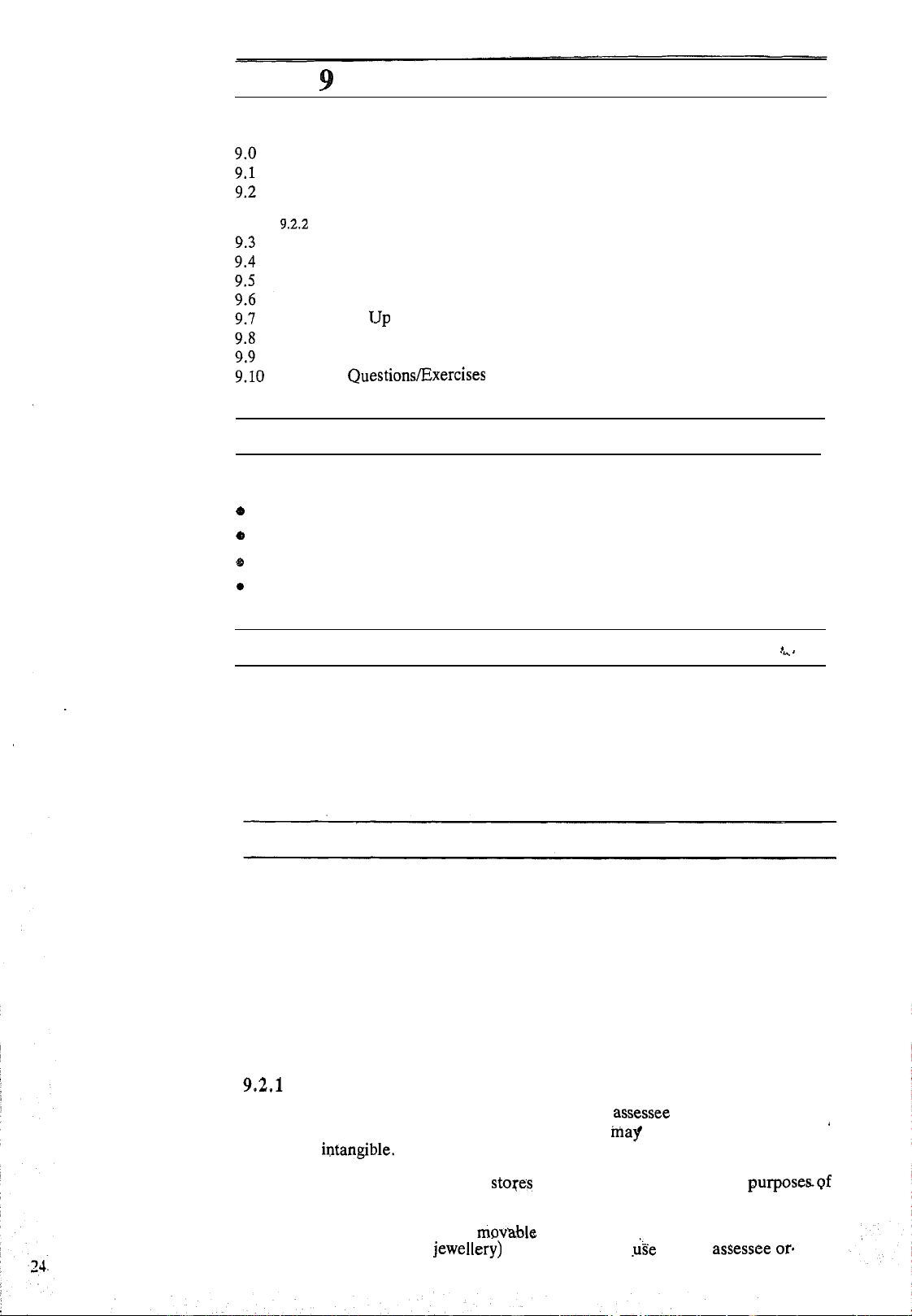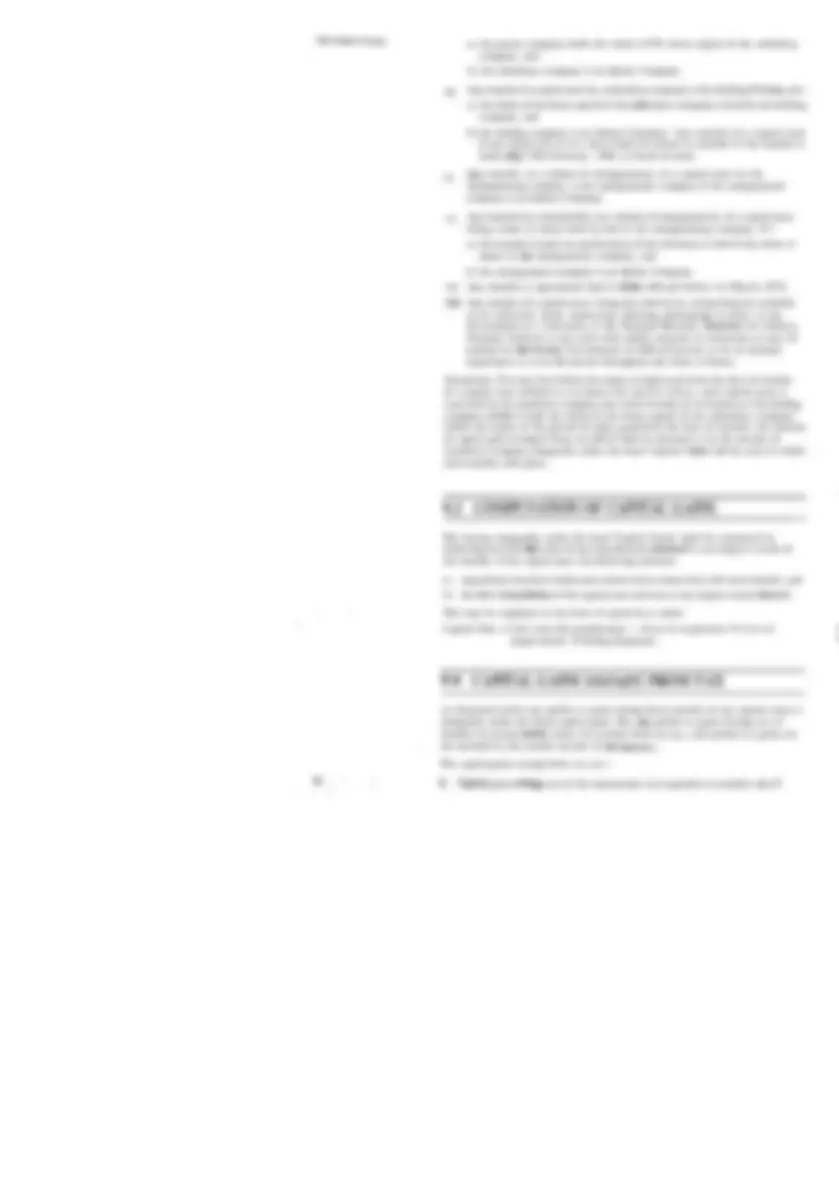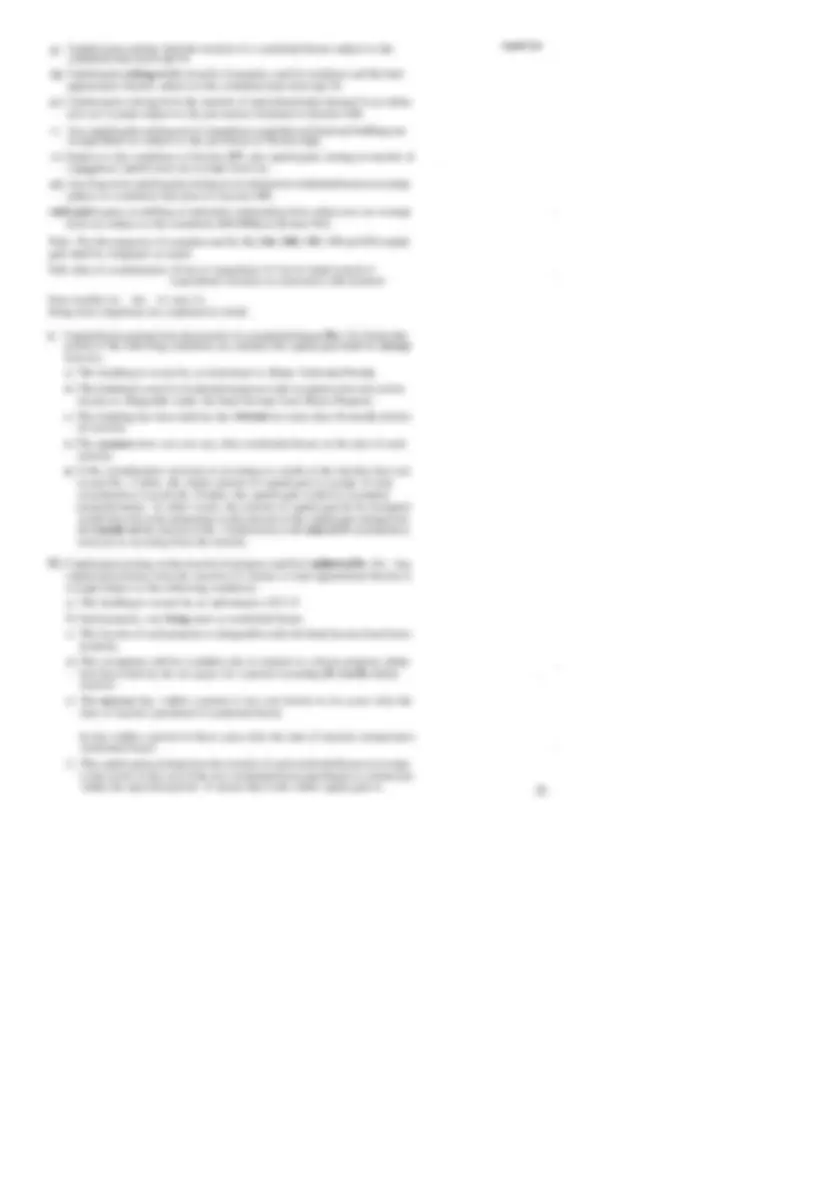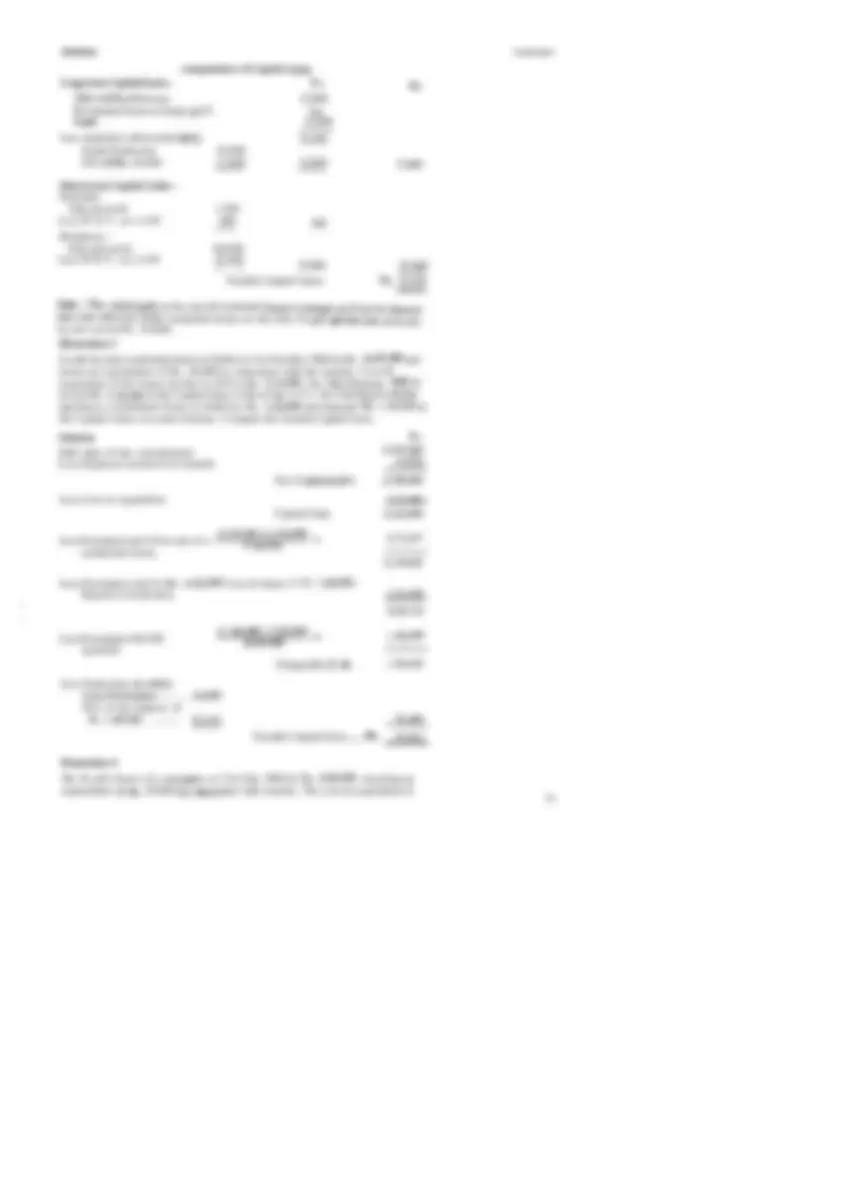








Study with the several resources on Docsity

Earn points by helping other students or get them with a premium plan


Prepare for your exams
Study with the several resources on Docsity

Earn points to download
Earn points by helping other students or get them with a premium plan
Community
Ask the community for help and clear up your study doubts
Discover the best universities in your country according to Docsity users
Free resources
Download our free guides on studying techniques, anxiety management strategies, and thesis advice from Docsity tutors
Heads of Incomes under the description of five types
Typology: Study notes
1 / 12

This page cannot be seen from the preview
Don't miss anything!







Objectives Introduction Meaning of Capital Gains '9.2.1 Concept of Capital Asset 9.2.2 Transfer of Capital Asset Computation of Capital Gains Capital Gains Exempt from Tax Deductions Allowed from long- term Capital Gains Computation of Taxable Income from Capital Gains Let Us Sum TJp Key Words Answers to Check Your Progress Terminal Questions/Exercises
9.0 OBJECTIVES
After studying this unit, you should be able to : 0 explain the meaning of the term capital gains; list the capital gains exempt from tax; 0 discuss the deductions allowed from long- term capital gains; compute the income chargeable under the .head capital gains.
9.1 INTRODUCTION L, I
You know 'capital gains' is a separate head of income and any income arising out of sale or transfer of'a capital' asset is charged to tax under this head. In this unit, you will study the meaning of capital gains, items included in capital gains capital gains exempt from tax and the deductions allowed from capital gains. You will also study how the taxable income from capital gains is calculated.
9.2 MEANING OF CAPITAL GAINS
ii) personal effects, that is to say, movable property (including wearing apparel and furniture but excluding jewellery) held for personal .use by the assessee or. any membet of his family dependent on him;
Any profits or gains arising from the transfer of a capital asset effected in the previous year shall be chargeable to income-tax under the head 'Capital Gains', and shall be deemed to be the income of the previous year in which the transfer took place. The above definition can be split up into three parts:
(b) Transfer of Capital Asset (c) Profits or Gains Let us now discuss each one of them in detail:
9. 2. 1 Concept of Capital Asset Capital asset means property of any kind held by an assessee whether or not connected with his business or. profession. The asset may be movable, immovable, tangible or iotangible. But the term capital asset does not include:
i) any stock - in- trade, consumable stoqes or raw materials held for the p u r p o s e s ~ f his business or profession;
iii) agricultural land in India (situated in rural areas) not being land situated within the limits of any municipality or a cantonment board having a population of 10,000 or more or situated in areas lying within a distance not exceeding 8 kilometres from the local limits of such municipalities or cantonment boards (i.e., agricultural land situated within municipal or cantonment board limits or within
iv) 6112% Gold Bonds, 1977 or 7% Gold Bonds, 1980 or National Defence Gold Bonds, 1980, issued by the Central Government.. v) Special Bearer Bonds, 1991.
Note : Capital assets include leasehdd rights, a partner's right to share in the profits of a firm and manufacturing license. For the purposes of clause ,(ii) jewellery includes: a) Ornaments made of gold, silver, platinum or any other precious metal, whether or not worked or sewn into any wearing apparel.
b) Precious or semi - precious stones, whether or not set in any furniture, utensil or other article or worked or sewn into any wearing apparel. Kinds of Capital Assets : Interestingly the classification of capital asset does not depend on their durability but the period for which they have been held. Capital assets are dividcd into two categories: (i) Short - term Capital Asset and (ii) Long - term Capital Asset. Short-term Capital Asset : Short - term Capital Asset means a capital asset held by an assessee for not more than 36 months immediately preceding the date of its transfer.. In the case of a share held in a company, short - term capital asset will mean a share held by the assessee for not more than 12 months instead of 36 months in case of other assets.
Long-term Capital Asset : Long - term Capital Asset means a capital asset (other than shares in a company) held by an assessee for more than 36 months immediately preceding the date of transfer. In the case of shares held in a company, long - term capital asset will mean shares held by the assessee for more than 12 months. Short- term and Long- term Capital Gains : Capital gains arising from the transfer of short - term Capital Assets are called short - term Capital Gains: Capital gains arising from the transfer of long - term Capital Assets are called Long - term Capital Gains.
9.2.2 Concept of Transfer Transfer in relation to a capital asset includes (i) sale, exchange or relinquishment of the assets, or (ii) the extinguishment of any rights therein, or (iii) the compulsory acquisition by the Government under ally law, or (iv) where the asset is converted by the owner thereof into stocklin-trade of a business canied on by him, such conversion. Further, where a business is converted into a limited company, there is n transfer of capital assets, o r (v) any transaction involving the allowing of the possession of any immovable property to be taken or retained in part performance of a contract of the nature referred to in the Transfer of Property Act, 1882, or (vi) any transaction which has the effect of transferring or enablin g the enjoyment of .any immovable property.
Transactions not regarded as transfer The following transactions are generally not regarded as transfer for the purpose of capital gains i) Any distribution of capital assets on the total or partial partition of a Hindu undivided family. ii) Any transfer of a capital asset under a gift o r will or an irrecoverable 3 9.^ t ~ s t ,,
Cupitul Gains
iii) Any transfer of a capital asset by a company to,its subsidisry company, if-
11) Capital gains arising from' the transfer of a residential house subject to the conditions laid down u/s 53.
Capitsl Gains
iii) Capital gains a;ising on'the transfer of property used for residence and the land appurtenant thereto subject to'the conditions laid down u/s 54. iv) Capital gains arising from the transfer of agricultural land situated in an urban area are exempt subject to the provisions contained in Section 54B. v) Any capital gains arising out of compulsory acquisition of land and buildings are exempt from tax subject to the provisions of Section 54D. vi) Subject to the conditions of Section 54E, the capital gains arising on transfer of (^) , a long-term capital asset are exempt from tax. vii) Any long - term capital gains arising on investment in residential houses is exempt subject to conditions laid down in Section 54F.. viii)Capital gains on shifting of industrial undertaking from urban area are exempt from tax subject to the conditions- laiadown in Section 54G. Note : For the purposes of exemption uis 53,54,54B, 54D, 54E, 54F and 54G capital gain shall be computed as under Full value of consideration -(Cost of acquisition + Cost of improvement + expenditure incurred in connection with transfer)
Item number ii), iii), iv) and vi) being more important are explained in detail.
ii) Capital Gains arising from the transfer of a residential house (Sec. 53) Under this section if the following conditions are satisfied the capital gain 'shall be exkmpt from tax: a) The building is owned by an Individual or Hindu Undivided Family b) The building is used for residential purposes (self-occupied or let out) and its income is chargeable under the head Income from House Property. c) The building has been held by the assessee for rnore than 36 months before its transfer. d) The assessee does not own any other residential house on the date of such transfer. If the consideration received or accruing as a result of the transfer does not exceed Rs. 2 lakhs, the whole amount of capital gain is exempt. If such consideration exceeds Rs. 2 lakhs, the capital gain would be exempted proportionately. In other words, the amount of capital gain fo be exempted would bear the same proportion to the amount of the capital gain arising from the transfer,as the amount of Rs. 2 lakhs bears to the amount'of consideration received or accruing from the transfer.
iii) Capital gains arising on the transfer of property used for ryidencedsec. 54) : Any capital gain'arising from the transfer of a house or land appurtenant thereto is exempt subject to the, following conditions: a) The building is owned by an individual or H.U.F. ,b) Such property was being used as residential house. c) The income of such property is chargeable under the head income from house property. d) The exemption will be available only in relation to a house property which
. had been held by the tax - payer for a period exceeding 36 monlhs befdre transfer. e) The assessee has, within a period of one year before or two years' after the
he has within a period of three years after the date of transfer constructed a residential house. f) The capital gains arising from the transfer of such residential house is exempt to the extent of the cost of the new residential house purchased or constructed within the specified period. It means that if, the whole capital gain is
Other Heads or Income (^) re - invested in the cost ofthe new house it is fully exempt from tax. If only a
part of it is re - invested, the balance of it is chargeable to tax. g) Where the amount of capital gain is not utilised by the assessee for acquisition of new house before the date of furnishing the return of income, it shall be deposited by him on or before the due date of furnishing the return of income U/S139, in an account opened under the Capital Gains Accounts Scheme, 1988, with State Bank of India or any of its subsidiaries or with any nationalised bank authorised by the Central Government. The amount already utilised for re - investment together with the amount of deposits shall be deemed to be the cost of the new house. After such deposit he must utilise the deposit for acquiridg the new house within 3 years.
gain arising on the transfer of agricultural land situated in an urban area is exempt subject to the following conditions : a) The agricultural land is owned by an individual. b) The agricultural land was, in the two years immediately preceding the date of transfer, being used either by the assessee or his parent for agricultural purposes. c) The assessee has purchased within a period of two years, from the date of transfer, any other land for being used for agricultural purposes. d) The capital gain arising from the transfer of such agricultural land is exempt to the extent of the cost of the new agricultural land purchased within the specified period mentioned in (c) above. It means that if the whole capital gain is re - invested it is fully exempt from tax. Jf only a part of it is re - invested the balance of it is chargeable to tax. e) 1f the amount of capital gain is not utilised by the assessee for acquisition of new agricultural land before the due date for furnishing the return of income,, it shall be deposited'by him on or before the due date of furnishing the return of income in an account opened under the Capital Gains Account Scheme,
v) Capital Gain on the transfer of long- term Capital Asset (Sec. 54E) : Any capital gain on the transfer of a long - term capital asset is exempt if the following (^) + 'conditions are satisfied: , I a) The assessee has transferred a long - term capital asset. b) The net consideration (i.e. net sale proceeds) has been invested in specified new asset by initially subscribing to such new asset within six months from the date of transfer of the asset. c) If a part of net consideration is invested, proportionate part of the capital gain will be exempt from tax. d) If the assessee receives some money as earnest money o r advance and invests in the specified assets before the date of transfer of asset, the amounl so invested will qualify for exemption under section 54E. e) Where the asset is transferred after 31.3.1989 the exemption will be available if the amount is invested in- i) Securities of the Central Government specified by^ that government in this behalf; ii) 'Special series of units of the Unit Trust of India specified by the Central '- Government in this behalf. Units issued under the Capital Gains Unit Scheme, 1983 have been notified for this purpose. iii) Notified National Rural Development Bonds. iv)+ Such debentures issued by the Housing and Urban ~ e v e T b ~ m e n tFinance ' Corporation Limited, as the Central Government may specify i n this belialf.
Other Heads of Income (^) as from long - term capital gains) and the balance amount shall be net'long - term capital
loss to be set - off against arly other capital gain or income under any other head. The net unabsorbed long - term capital losses will be allowed to be carried forward for 8 years as business losses to be set - off against capital gains only.
9.6 COMPUTATION OF TAXABLE INCOME FROM CAPITAL GAINS
After the amount of capital gains is calculated and the deduction uls 48(2) allowed the amount left is the income chargeable to tax under the head income from capital gains.
Let us now look at few illustrations to clearly understand the computation of income from capital gains.
Illustration 1 From the information given below compute the amount of capital gain that should be included under the head capital gains : \
Solution Selling price of the agricultural larid Less : Cost of acquisition of the land Long - term capital gain... .. Less. Cost of the new land purchased before the due date for furnishing the
Less : Deduction u/s 48(2): (Rs. 10,000 + 50% of Rs. 40,000)
Rs. 1,50, 2,50, 50,
Rs. 2,50, 1,50, 1,00,
Capital gain for inclusion in income under the head capital gains 20:
Illustration 2 During the year ending 31s.t March 1990, Mr. X sold the following assets: Sale Proceeds
Rs. 50,000 sold on 15th February 1990 90, During the year before the due date for filing the return of income he bought another house for the residential purposes for Rs. 40,000. Work out the amount of capital gain to be included in his'total income.
Solution computation of Capital Gains Long-term Capital ~ a i & : Rs. Non-residential house 22, Residential house exempt u/s 53 (^) Nil Land 14, Less deduction allowed u/s 48(2) (^) 36, Initial Deduction ' 10, 50% of'Rs. 26,000 13,000 23,
Short - term Capital Gains : Furniture Sale proceeds 1,
Sales proceeds 60, Less W.D.V. on 1.4.89 35,
Taxable Capital Gains Rs. 38,
Note : The capital gain on the sale of residential house is exempt u/s 53 as the assessee does not own any other residential house on the date of sale and the sale proceeds
Illustration 3 A sells his only residential house in Delhi on 31st October 1989 for Rs. 16,00,000and incurs an expenditure of Rs. 40,000 in connection with the transfer. Cost of, acqu isition of the house by him in 1976 is Rs. 2,10,000. On 28th February 1990.he invests Rs. 5,20,000 in the Capital Gains Units of the U.T.I. On 15th March 1990 he purchases a residential house in Delhi for Rs. 4,00,000 and deposits Rs. 1,50,000in the Capital Gains Account Scheme. Compute the taxable Capital Gain.
Solution Rs. Full value of the consideration 16,00, Less Expenses incurred on transfer 40, Net Consideration 15',60,
Less Cost of acquisition 2,10, Capital Gain 13,50,
Less Exemption u/s 53 for sale of = 13,50,000 X 2,00,000 - - residential house
Less Exemption u/s 54 (Rs. 4,00,000 Cost of house + Rs. 1,50, Deposit intC.G.A/c) 5,50, 6,26,
13,50,000 X 5,20,000 - - (general)
Less Deduction uls 48(2): Initial D6duction ..........10, 50% of the balance of Rs. 1,66,923 .......... 83,461 93, Taxable Capital Gain., ... .Rs. 83,
Illustration 4 Mr. R sells shares of a company on 31st July 1989 for Rs. 9,00,000, incurring an expenditure of&. 50,000 in.connection with transfer. The cost of acquisition of
vi) Assessee 'A' purchased a residential house on 1.5.1984 for Rs. 50,000 and .started living in it. On 1.8.1989 he sold this house for Rs. 80,000. He constructed another residential house for self - occupation at a total cost of Rs. 70,000 in December 1989. Capital gains to be included in his assessment for assessment year 1990-91 are: ;I) Rs. 10,000; b) Rs. 15,000; c) Rs. 14,400; d) Nil
9.7 LET US SUM UP
Any profits or gains arising from the transfer of a capital assqt affected in the previous
. (^) year shall be chargeable to income - tax under the head 'Capital Gains'. Capital asset means property of any kind held by an assessee whether or not connected with his business' or profession, but does not include stock - in - trade, personal effects and, agricultural land in India. Capital assets are of two types-long-term and short - term. Long - term capital assets are those which are held by the assessee for more than 36 months before transfer and short - capital assets are those which are held by the assessee for not more than 36 months before transfer. Capital gains arising from the transfer of short - term capital assets are called short - term capital gains and capital gains arising from the transfer of long - term capital assets are called ldng - term capital gains.
Transfer of a capital asset means sale, exchange or extinguishment of any rights therein, or its compulsory acquisition under any law or its conversion into stock - in - trade etc. . (^) The income chargeable under the head 'Capital Gains' sllall be computed by deducting from the full value of the consideration received or accruing as a result of the transfer of the capital assets: (i) expe~ditureincurred wholly and exclusively in connection with the transfer, and (ii) the cost of acquisition of the capital asset and cost of any. improvement thereto.
Only long - term capital gains are exempt from tax under Section 53,54,54E, and 54F,
under sections 54B, 54D and 54G subject to fulfilment of certain conditions.
In the case of long - term capital gains an initial deduction of Rs. 10,000 is made and thereafter on the balance of such capital gain deduction at specified percentage will be allowed on specified nature of capital gains. The net balance left thereafter shall be taxable capital gain.
In case of long - term capital losses also deduction shall be made in the same manner
shall be net long - term capital loss to be set - off and/or carry forward. ,
Capital Gains
Other Heads or Income T , 9-8 KEY WORDS
Capital Asset : Capital asset means property of any kind held by an assessee, whether or not connected 'with his business or profession except stock - in - trade, personal effects and agricultural land in India. Capital Gains : Profits or gains arising from the transfer of a capital asset is called capital gain.
9.9 ANSWERS^ TO^ CHECK^ YOUR^ PROGRESS
A 1) i) b; ii) c; iii) c (Personal effect); iv) a; v) d; vi) d.
Questions (^) I
got this house from his uncle as a gift on 15th July, 1984. His uncle purchased this ' house in 1972 for Rs. 56,000. Its fair market value on April 1, 1974, was Rs, 70, and on January 1, 1981, it was Rs. 1,10,000. Mr X spent Rs. 5,000 on its improvement and sold it on 30th November, 1989 for Rs.,2,00,000. He purchased another house for his residence on 25th February, 1990 for Rs. 1,00,000.
He had purchased the second house for Rs. 50,000 in 1975 and had let out for residential purpose. H e sold this house on 15th June, 1989, for Rs. 90,000 and purchased another residential house on 18th March, 1990, for Rs. 60,000.
He had purchased some jewellery in 1976 for Rs. 70,000. On 22nd February, 1990, he sold this jewellery for Rs. 1,50,000and purchased on 15th March, 1990, notified , National Rural Development Bonds of Rs. 75,000.